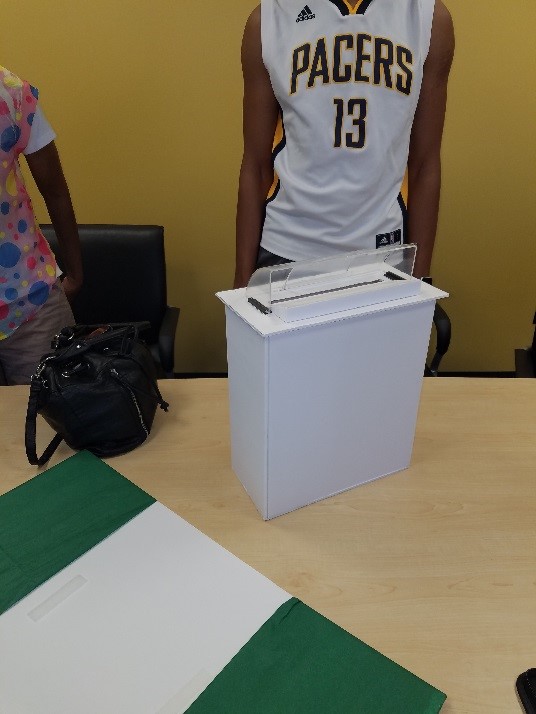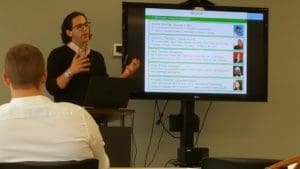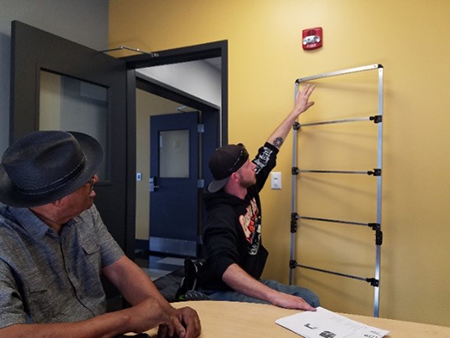Projects

The Commercialization Process at PNW CMEC would be recognizable at any incubator or tech accelerator.
Concept Viability
Prospective client ideas or concepts are evaluated through the PNW/CMEC concept viability stage of evaluation. The prospective clients themselves are also being evaluated, to some extent at this stage.
The CMEC entrepreneur in residence/associate director meets with innovators and undertakes a preliminary technical, market, and competitive assessment of the concept or innovation. Subsequent technical investigation or early stage research may be conducted by CMEC design and development techs, PNW faculty, grad students or technical staff to determine viability.
CMEC’s first assignment to clients is to make a conceptual prototype, if one does not already exist or provide a drawing. Conceptual prototypes can be made from cardboard, duck-tape, playdough, or any simple material that can visually convey the concept.
At this concept viability stage of assessment, prospects are also asked to draft a brief executive summary of the business plan. If they do not know how to formulate an executive summary they are referred to the local office of the Indiana Small Business Development Center. Assessing both the innovation and the innovator determines whether CMEC should offer continued support for product and entrepreneur development.
Entrepreneurial Viability
Entrepreneurial viability is a key indicator for CMEC to determine if the innovator is capable of communicating, or even willing to learn to communicate their innovation confidently and effectively.
 Can they deliver a business pitch deck to investors? Can the demo their product to customers effectively? With a limited pool of resources CMEC needs to determine if the client is “coachable” and willing to put in the work to become an effective communicator.
Can they deliver a business pitch deck to investors? Can the demo their product to customers effectively? With a limited pool of resources CMEC needs to determine if the client is “coachable” and willing to put in the work to become an effective communicator.
The probability of success of a venture increases significantly if the principal innovator can explain and sell their idea simply and comprehensively. Therefore, an early CMEC assignment is to require clients to offer a business presentation at the weekly 1 Million Cups/Hammond chapter, that conveniently meets at CMEC each Wednesday morning. Clients may also pitch at the annual **PNW Big Sell,** which is co-chaired by the CMEC entrepreneur in residence and has been a PNW staple since 2011.
If a client has participated or won another regional business pitch competition, then that would certainly meet the requirement. If a client is not a confident or effective public speaker, then they are encouraged to join a public speaking group like Toastmasters.
Intellectual Property Viability
Determining intellectual property viability is a critical step. Is the product idea novel or innovative and is there any probability that the product is protectable through a U.S. Patent? How is the product different from what already exists in the market? How does it surpass the current competition?
If the client has not yet initiated a patent search or prior art search, they are required to meet with a patent attorney at CMEC’s monthly Intellectual Property Legal Aid (IPLA). IPLA is a free initial consultation and is designed to provide IP protection counseling and offer clients a roadmap toward patent protection. Depending on whether the client is faculty, student or regional resident, different paths are recommended.
Students/grad students at PNW and Purdue (or independent regional residents) are the owners of their ideas, concepts and student projects, according to Purdue University. It is recommended that they file a provisional patent or conduct a prior art search at the earliest convenience.
Faculty clients are a bit more complicated as projects they have pursued with university assets and funding are generally considered the property of the university and therefore, faculty is often referred to the Purdue University Office of Technology Transfer in West Lafayette.
 CMEC has taken steps to receive a 50 percent discount on legal services from IPLA partner, Hartman Global IP Law for supported clients. A CMEC program called Concept to Commercialization (C2C) supports the IP protection activity of client innovations.
CMEC has taken steps to receive a 50 percent discount on legal services from IPLA partner, Hartman Global IP Law for supported clients. A CMEC program called Concept to Commercialization (C2C) supports the IP protection activity of client innovations.
Ideally, CMEC would like to see the client invest their own assets into IP protection. However, if the innovative product and client show promise but have no ability to fund vital IP protection themselves, CMEC may issue a Simple Agreement for Future Equity (SAFE) and Concept to Commercialization Micro-grant to assist with IP protection.
Customer Viability
The customer-viability stage of commercialization may begin with conceptual prototypes and perhaps the concept itself. However, customer acceptance of a product really cannot be judged until the functional prototype is demonstrated. They will either want to purchase or reject this product idea based on pushing buttons and discerning first hand if it will solve a probleme or benefit them in any way.
A prospective CMEC client should allow their project to fail or to reevaluate, or to reiterate the product before too much time and money is wasted on a product that no one, or few, will buy.CMEC encourages customer interaction early in the ideation or concept viability process and its always a cautionary marker if the innovator hesitates to conduct any customer survey. It is, however, a mandatory assignment for CMEC clients of manufactured products to survey 100 potential customers and request their feedback on the design, proposed price and usefulness of innovation once a functional prototype is available.
They are asked to request letters of support or field sales commitments before any additional CMEC development or further stages of commercialization will be offered/provided. It is also recommended at this stage for clients to organize their company, prepare SWOT Analysis and estimate financial projections. Regulatory, economic and legal strengths and weaknesses should be identified at this stage.
Product Viability
 Development of a functional prototype will aid in the product-viability assessment. A CMEC client who has met every previous assessment is assigned to a CMEC design and development technician, senior capstone student, graduate student or faculty member to produce a functional prototype.
Development of a functional prototype will aid in the product-viability assessment. A CMEC client who has met every previous assessment is assigned to a CMEC design and development technician, senior capstone student, graduate student or faculty member to produce a functional prototype.
The client is required to demonstrate the efficacy and scientific feasibility of their functional prototype. CMEC recommends they pursue seed funding via business pitch/presentation competitions or the Small Business Innovation Research (SBIR) program.
Ideally, CMEC would like to see the client invest their own assets into the development of a functional prototype, but barring a lack of funds or technical expertise, CMEC will offer a SAFE agreement to fund the development, if the innovation has a reasonable expectation of earning a patent and appears to meet priorities of SBIR programs. CMEC may also utilize the C2C Micro-grant to assist clients with SBIR grant application preparations/submissions. At the time of this writing two CMEC clients have SBIR grants pending and four additionally are preparing applications, but none have used C2C resources.
Commercial Manufacturing Viability
If customer surveys or SBIR Phase I results show promise, then CMEC clients will move into the commercial-manufacturing viability stage of commercialization. Manufacturing analysis can examine existing production methods or engineer new manufacturing processes for the product. If the product is innovative and patented or patentable, then SBIR Phase I and/or Phase II can provide the means to prove scientific feasibility and “proof of concept.” CMEC lab space can be scheduled to build out a scale-production facility that proves commercial viability for the client company.
As this stage approaches CMEC clients are assignment to pursue private equity investment or seed funding through SBIR or similar programs. They must attend SBIR workshops and participate in grant-writing programs, or hire a grant writer, to increase the chances of securing funds. It is proven that pre-submissions reviews can increase a client’s chances of securing an SBIR grant so CMEC may also utilize the C2C Micro-grant to assist clients with SBIR Phase II grant application preparations/submissions.